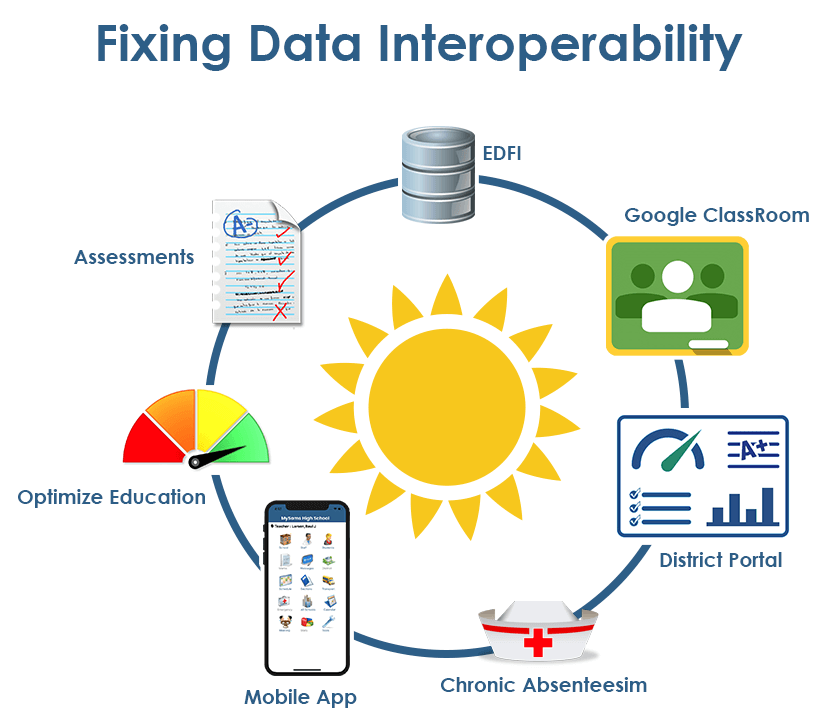Ed-Fi Data Standard

Data is critical in education to drive informed decision-making and improve student outcomes. However, due to its disparate nature, the education sector has historically faced challenges in efficiently collecting, managing, and utilizing data. To address this issue, the Ed-Fi Alliance introduced the Ed-Fi Data Standard—a comprehensive framework designed to standardize education data, facilitate interoperability, and enable data-driven insights that can revolutionize the educational landscape.
The Ed-Fi Data Standard was conceived to create a common language for education data. It enables seamless integration and exchange of educational data across various systems, applications, and organizations, fostering a cohesive and holistic understanding of student performance, engagement, and progress.
Origins and Purpose of Ed-Fi Data Standard
Recognizing the need for a standardized approach to education data, the Alliance collaborated with educators, technologists, and policymakers to develop the Ed-Fi Data Standard. This collaborative effort aimed to streamline data management and reporting processes, enhance data accuracy, and ultimately facilitate data-driven decision-making in education.
The fundamental purpose of the Ed-Fi Data Standard is to empower educators, administrators, policymakers, and researchers with a common data framework. Unifying the data structure and definitions allows for seamless integration of diverse educational data sources, creating a comprehensive view of student performance, behaviors, and circumstances.
Core Components of Ed-Fi Data Standard
Data Models: The Ed-Fi Data Standard encompasses robust data models defining education data structure, relationships, and attributes. These models cover various educational domains, including students, assessments, attendance, demographics, etc. The standardized models ensure consistency and interoperability across educational systems.
APIs (Application Programming Interfaces): Ed-Fi APIs provide a standardized way for different systems to access and exchange data. These APIs enable secure and efficient data sharing, allowing applications to communicate and retrieve information from various education data sources.
Connectors: Ed-Fi Connectors are pre-built integration solutions that facilitate the integration of disparate data systems with the Ed-Fi Data Standard. These connectors simplify connecting existing educational information systems to the Ed-Fi Data Standard, minimizing integration challenges.
Dashboards and Reporting Tools: The Ed-Fi Data Standard supports the development of dashboards and reporting tools, enabling educators and stakeholders to derive meaningful insights from the integrated data. These tools facilitate data visualization and analysis, aiding in monitoring student progress, identifying trends, making informed decisions, and offering Ed-Fi education solution.
Identity Management and Authentication: Ed-Fi ensures secure access to educational data through robust identity management and authentication mechanisms. This is crucial in maintaining data privacy and security while allowing authorized users to access and use the data effectively.
Advantages of Implementing Ed-Fi Data Standard
Interoperability and Integration: One of the primary advantages of adopting the Ed-Fi Data Standard is the ability to integrate and interoperate with various educational systems seamlessly. It breaks down data silos and allows for a comprehensive view of student information, enabling educators to make data-driven decisions.
Data Accuracy and Consistency: The standardized data models in the Ed-Fi Data Standard ensure consistency and accuracy in education data. Uniform data representations reduce errors and discrepancies, providing a reliable foundation for analytics and reporting.
Efficiency in Data Sharing and Reporting: Ed-Fi APIs and connectors streamline data sharing and reporting processes. Educators and administrators can easily access and exchange data across systems, saving time and resources that would have been otherwise spent on manual data entry and reconciliation.
Informed Decision-making and Targeted Interventions: By accessing comprehensive and accurate data, educators and policymakers can make informed decisions to tailor interventions and support to individual student needs. This ultimately improves educational outcomes and student success rates.
Enhanced Collaboration and Research Opportunities: The standardized data format encourages collaboration and data sharing between educational institutions, researchers, and policymakers. Researchers can analyze larger datasets, identify patterns, and contribute to the continuous improvement of educational practices.
Challenges and Future Outlook
Challenges persist while the Ed-Fi Data Standard has made significant strides in standardizing education data. Adoption and implementation across diverse educational environments can be complex and resource-intensive. Overcoming resistance to change, addressing data privacy concerns, and ensuring sustained support are critical aspects to consider.
Looking ahead, technological advancements, such as machine learning and artificial intelligence, will likely influence the evolution of the Ed-Fi Data Standard. These technologies can enhance data analysis and provide deeper insights into student behaviors and learning patterns, further optimizing educational strategies and outcomes.
Overcoming Challenges and Ensuring Growth
Despite its advantages, widespread adoption of the Ed-Fi Data Standard faces challenges related to implementation complexity, data privacy concerns, and change management resistance. Successful deployment requires a strategic approach that includes comprehensive training, stakeholder engagement, and robust privacy protocols. Embracing emerging technologies like machine learning and AI holds promise in enhancing data analysis capabilities, providing deeper insights into student behaviors, and refining educational strategies. Continuous refinement and adaptation will be key to addressing evolving needs and maximizing the Ed-Fi Data Standard’s potential in the ever-evolving education landscape.
Conclusion
The Ed-Fi Data Standard has emerged as a vital tool in education, addressing the longstanding issue of disparate and unmanageable data. Providing a standardized approach to education data paves the way for a more informed, efficient, and collaborative educational ecosystem. As adoption grows and technology continues to evolve, the Ed-Fi Data Standard will play an increasingly pivotal role in shaping the future of education, ensuring that every student has the opportunity to thrive and succeed.